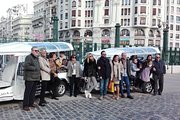Mediaeval remains
Mediaeval remains
The majority of the urban and demographic development of the middle ages took place in what we know today as the Ciutat Vella, the historical centre of Valencia.
In particular, the Carmen neighbourhood passes on the memory of these ages of splendour, the Valencian Golden Age (14th and 15th centuries) and the Taifa of Valencia (independent Moorish kingdom of Valencia between 1010 and 1238).
Muralla Arabe
From the beginning of its days until today, Valencia has known three different sets of city walls: Roman, Moorish and Christian. We only have remains of the last two walls, and the remains of the Muralla Arabe (meaning Arab Walls in English) can be found in the Carmen neighbourhood.

Under Muslim rule (711-1238), a fortified perimeter of the city was built. Most of the remains we have nowadays were constructed between 1021 and 1061. Unfortunately, the condition of these few remains is not ideal. They can only give us a glimpse of the splendour of Valencia’s Muslim past and its walled enclosure.
Here is a list of where you can find these remains, often integrated into houses or local businesses.
Carrer d’en Borràs
Here you’ll find a semicircular tower (Torre del Ángel), today converted into a house, which originally formed part of the 11th-century wall. Next to the towers remains a piece of the ancient wall itself.
Muralla Arabe under restoration

Calle de Salinas
The remains found here are particularly exposed and battered by time, but you’ll still be able to appreciate the 2-metre thick (6.5 feet) masonry wall.

Calle Blanqueria
Inside a private building on this street is a perfectly restored remnant of the old Muslim walls, which separated the city from the river. A group of battlements that crowned the wall are still preserved, while a semicircular tower can be found on the inside.
Calle Roteros
At the intersection with Calle Palomino, you can find a piece of the ancient wall inside a local bakery, the Horno Montaner.

Galeria del Tossal
Inside this underground art gallery you can find a 20-metre long (almost 66 feet) section of the wall and a square tower. The gallery is located in Plaza del Tossal, which stands at the edge between the Carmen and the Mercat neighbourhoods.

Torres de Quart
The Torres de Quart (Quart towers), built between 1443 and 1469, are an example of Gothic military construction in Valencia. These towers, together with the Serranos towers, are the only (more or less) intact remains of the city’s Christian defence wall.
This construction played a key role in stopping Napoleon’s troops in 1808, and it still bears the scars left by their cannonballs.

The Quart towers are located at the southwestern edge of the Carmen neighbourhood, where Carrer de Quart and Carrer de Guillem de Castro meet (view map above).
If you want to know more about this defence gate, you can read our article about the Quart towers.
Torres de Serranos
The Serranos Towers were, as the Quart Towers, one of the gateways to the old city of Valencia, acting as one of the twelve entrance points along the Christian city wall, today dismantled.
Built between 1392 and 1398, they present a unique blend of military and ceremonial Gothic architecture and have served many non-military functions throughout history.

The Serranos Towers are located at the northeastern edge of the Carme neighbourhood, right in front of the Serranos Bridge (view map above).
If you would like to find out more about this gate, you can read about it in our article about it*.*
Portal Valldigna
Portal de la Valldigna is a gateway that used to separate the Moorish quarter of Valencia from the rest of the (then Christian) city.
This door is in the eastern section of the neighbourhood, where Carrer del Portal de Valldigna meets Carrer de les Salines (view map above).

Moorish quarters (called morerías in Spanish) were urban areas inhabited by the Moorish population in mediaeval Christian cities and towns. After the Christian reconquest of Spain, they were quite common across the country.
The Valldigna gateway is not a proper door, but rather a semi-circular arch carved out of an existing wall. Although the Portal was opened in the 1400s, the wall in which it was opened used to be the Muslim wall of the city, built in the 11th century.
The gateway takes its name after the Monastery of Santa María de la Valldigna, whose abbot lived in front of the Portal. On the side of the doorway, there is an inscription dedicated to the Virgin.


















